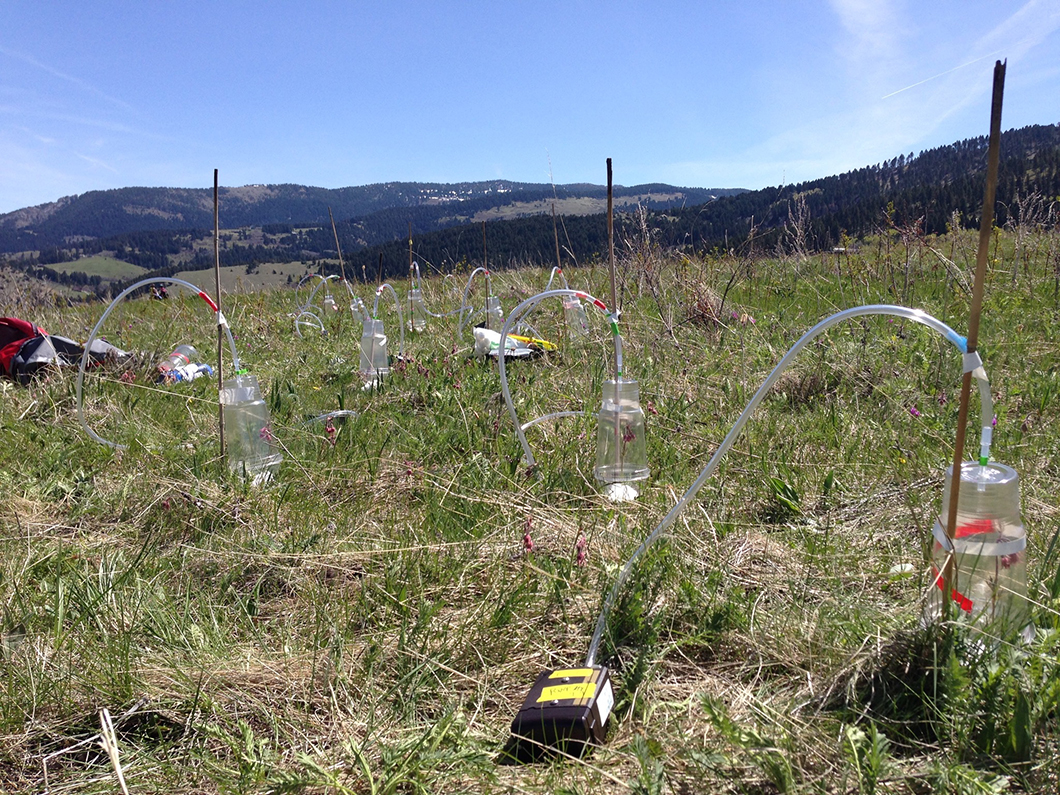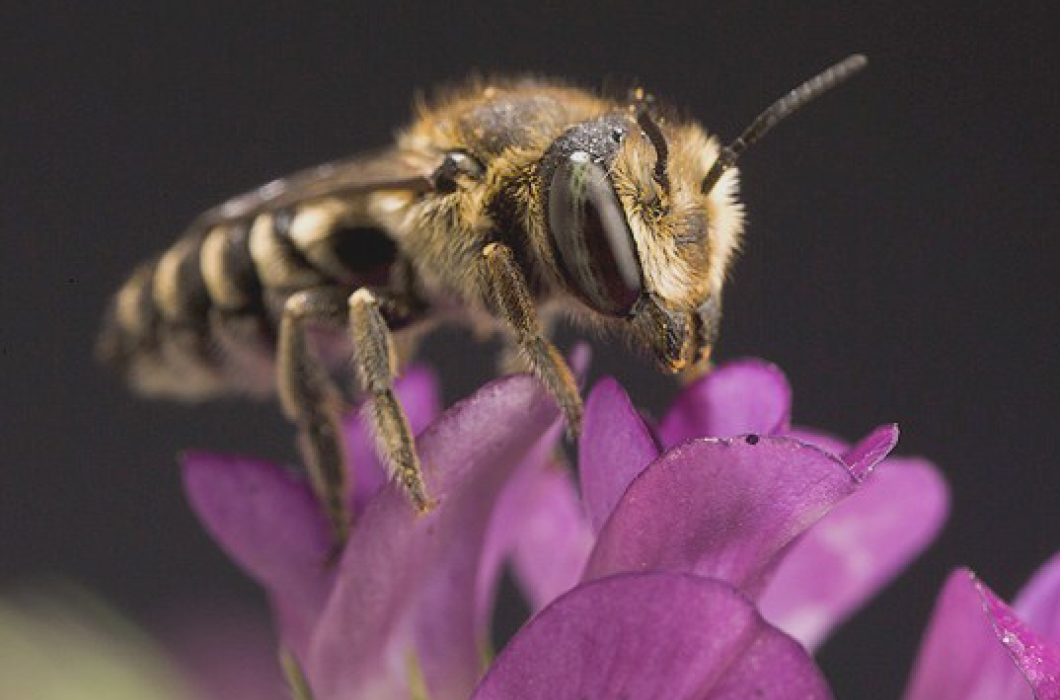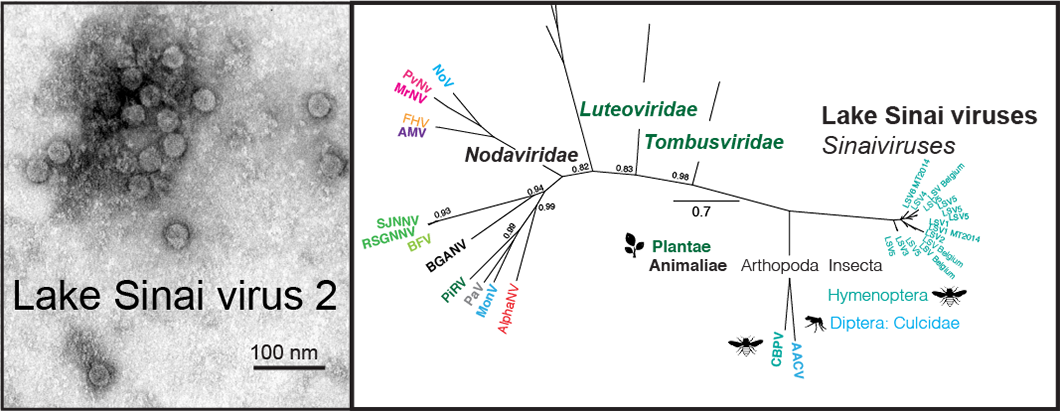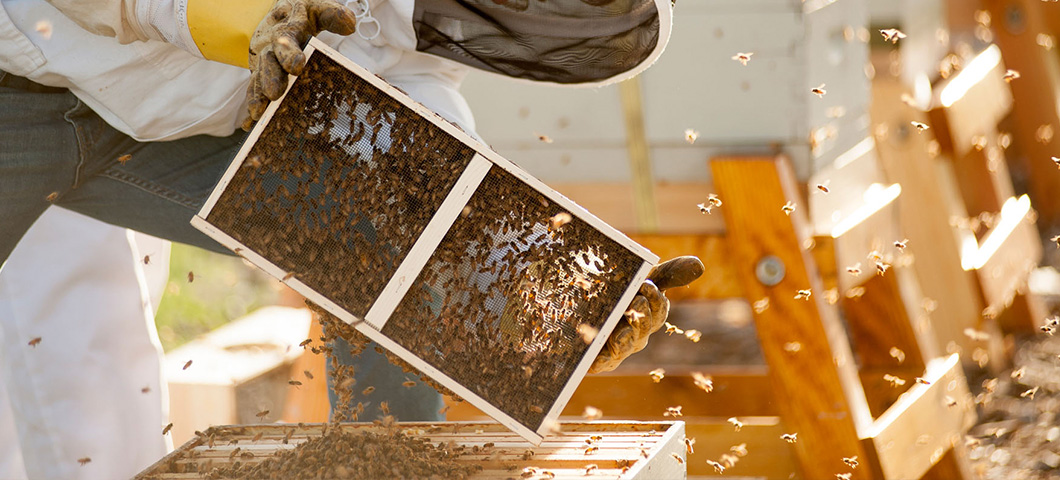Research
Members of the Pollinator Health Center at Montana State University are engaged in research that advances our knowledge of pollinator behavior and the factors that impact pollinator health.

Understanding biotic and abiotic factors affecting honey bee health
Michelle Flenniken is directing a USDA-AFRI funded project aimed at improving the health of the U.S. honey bee pollination force by better understanding biotic (pathogens and microbes) and abiotic (agrochemical) factors affecting individual bee and colony health. This project utilized advanced methods including mass spectrometry based metabolomics to assess the physiologic effects of virus infection and agrochemical exposure, and next generation sequencing to identify the microbial flora associated with weak and strong colonies. The goal of this research is to determine the factors that are most associated with colony loss. Increased understanding of these factors may lead to strategies that mitigate honey bee colony losses, and benefit crop production.

Ecological drivers of plant-pollinator biodiversity and ecosystem function across spatiotemporal scales
Laura Burkle is directing an NSF funded project to examine the ecological drivers of plant-pollinator biodiversity and ecosystem function across spatiotemporal scales. Disturbance is a key driver of biodiversity across spatiotemporal scales. However, natural disturbance regimes have been altered, and the severity of some disturbances is forecasted to increase with global change. Although ecologists have excelled at investigating how individual species and some local communities respond to disturbances, we lack a synthetic local understanding of how complex networks of species interactions recover from disturbances, especially at the large spatial scales most germane to conservation and management in naturally heterogeneous landscapes. In collaboration with Travis Belote (The Wilderness Society) and Jonathan Myers (Washington University), we are studying how spatial variation in the composition of plant and pollinator communities (beta-diversity), spatial variation in plant-pollinator interactions (interaction beta-diversity), and ecosystem services (pollination) respond to wildfire disturbance across a large- scale gradient of net primary productivity and regional biodiversity in the Northern Rockies Ecoregion of Montana. A major goal of this interdisciplinary collaboration is to enhance mechanistic understanding of community assembly, species interactions, and ecosystem services following disturbance in a biogeographically diverse but understudied region of critical conservation importance. We thank the Montana Forest Restoration Committee and the National Science Foundation for supporting this project.

Understanding the roles of plant volatiles in plant-pollinator interactions at a community scale and under climate change
Laura Burkle and Justin Runyon (Rocky Mountain Research Station, USFS), are combining chemical ecology techniques and community network analyses to determine 1. the roles of floral and vegetative volatiles in community-level plant-pollinator interactions and 2. the effects of CO2, temperature, and drought on floral volatiles important for pollinator attraction and pollination services. We are growing different forb species under elevated CO2 and drought conditions and will measure effects of these treatments on plant traits, volatiles, herbivory, and pollinator visitation. We thank the Forest Service for supporting this work, which will also be used to motivate additional proposals and experiments.

The effects of microbial and environmental factors on bee health and pathogen transmission
Michelle Flenniken (MSU) is leading research to measure and model the effects of microbial and environmental factors on bee health and pathogen transmission. This study includes a longitudinal monitoring project, sampling migratory honey bee colonies and co-occurring populations of bumble bees in Montana. We are using pathogen-specific PCR and quantitative PCR to measure the incidence and abundance of bee-associated viruses and microbes. A better understanding of relationships between colony health, pathogen load, and interspecies pathogen transmission may lead to the development of strategies that mitigate bee losses. Funds from the VPR at Montana State University were granted for this research.

Evaluating native perennial flower strips for enhancing native bees and pollination services on farmlands
Laura Burkle, Casey Delphia and Kevin O'Neill (MSU), are quantifying the benefit of native perennial flower strips on farms for pollinator conservation and pollination services to crops.
The specific objectives of this project are to:
- determine the effects of flower strips on the abundance, diversity, and foraging behavior of native bees in crop fields;
- determine the value of flower strips in improving crop pollination;
- evaluate the potential of flower strips for native seed production and sales; and
- execute a research-based outreach program to communicate our findings to producers, land managers, agricultural professionals, and the public.
This project will provide valuable information on the biology and ecology of native bees on farmlands in general and in Montana specifically. Our long-term goals are to advance management strategies that support healthy, sustainable pollination systems in agriculture for ensuring food security and supporting environmental quality. We thank the Western Sustainable Agriculture Research and Education program for supporting this project.

Risks to pollinating bees from adult mosquito control
Bob Peterson (MSU) is leading a research project aimed at understanding mortality risks of bees to insecticides used for mosquito management. The project is supported by a grant from the Mosquito Research Foundation. The insecticides currently used for management of adult mosquitoes are broad-spectrum and highly toxic to most bees, but toxicity is not the same thing as risk. Moreover, risk information is not available for real-world exposures of non-honey bee pollinator species to these products. We are conducting research on the honey bee and the alfalfa leafcutting bee, an important non-honey bee pollinator in the western U.S. that can also serve as a surrogate for other solitary bees. This research encompassing three primary objectives is providing knowledge about the risks to bees from exposure to adult mosquitocides. The objectives are to determine: (1) LD50 values (the dose that causes 50% mortality) for alfalfa leafcutting bees when exposed to three mosquitocides; (2) the effects on foraging alfalfa leafcutting bees and honey bees the day after field applications of mosquitocides; and (3) the effects on populations of alfalfa leafcutting bees after field applications of etofenprox.
Alfalfa leafcutter photo from pollinator.ca

Montana’s bee viruses: identification and transmission
Michelle Flenniken (MSU) is leading a Montana Department of Agriculture Specialty Crop Block Program supported project aimed at identifying the strains of a highly abundant virus family (the Lake Sinai viruses 1- 7+) circulating in Montana, and investigating the route(s) of virus transmission within and between honey bee colonies. Understanding the route(s) of virus transmission is critical to developing and/or employing strategies to minimize virus transmission (e.g., reducing mite loads, testing queen-rearing colonies). It is also important to document which strains of this virus are currently circulating in Montana, since three of the five known strains of LSV have been associated with increased colony losses in the U.S. and Belgium.

